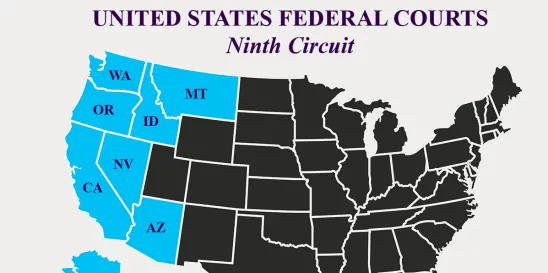The US Court of Appeals for the Ninth Circuit denied a petition for panel rehearing and rehearing en banc and issued an amended opinion that reversed a district court’s decision regarding the False Claims Act’s (FCA) public disclosure bar. Silbersher v. Valeant Pharm. Int’l, Inc., Case No. 20-16176 (9th Cir. Aug. 3, 2023; amended Jan. 5, 2024) (Schroeder, Sanchez, Antoon, JJ.)
The FCA imposes civil liability on those who knowingly present a fraudulent claim for payment to the federal government and allows “relators” to bring fraud claims on behalf of the government.
Valeant owns a set of patents that cover a delayed-release formula for a medication prescribed to treat ulcerative colitis. In 2015, a generic drug manufacturer, GeneriCo, challenged one of Valeant’s patents in an inter partes review (IPR) proceeding. Ultimately, the Patent Trial & Appeal Board found Valeant’s patent unpatentable based on two articles co-authored by Valeant’s head of research.
Silbersher was GeneriCo’s lawyer in the IPR proceeding. He discovered that three years before applying for the challenged patent, Valeant had applied for another patent that disclosed the exact opposite of what Valeant would claim in the challenged patent. Silbersher brought an FCA action alleging that Valeant failed to disclose this information in the IPR proceeding. In response, Valeant argued that the public disclosure bar applied. The district court decided that an IPR qualified as an “other Federal hearing” under channel (ii) of the public disclosure bar and dismissed Silbersher’s action. Silbersher appealed.
On appeal, the Ninth Circuit reversed the district court. Valeant filed a petition for panel rehearing and rehearing en banc. The Court issued an amended decision that refocused on its analysis under its 2016 decision in Mateski v. Raytheon. Under Mateski, the public disclosure bar applies when “the disclosure at issue occurred through one of the channels specified in the statute; the disclosure was ‘public;’ and the relator’s actions are ‘based upon’ the allegations or transactions publicly disclosed.”
The Ninth Circuit discussed whether Valeant’s disclosures revealed “substantially the same allegations or transactions” as Silbersher’s qui tam action. As discussed in the original decision, this was a first for this court, which had not yet “interpreted substantially the same prong of the public disclosure bar” under the 2010 Congress amendments. Mateski explained that to disclose a public fraudulent transaction according to the formulation X+Y=Z (where Z is the fraud allegation and X and Y are the essential elements), “the combination of X and Y must be revealed from which readers or listeners may infer Z, the conclusion that fraud has been committed.”
The Ninth Circuit then applied the Mateski framework to conclude that the qualifying public disclosures here did not collectively disclose a combination of facts sufficient to permit a reasonable inference of fraud. It explained that although “scattered disclosures when viewed together possibly reveal some of these true and misrepresented facts,” fraud could not reasonably be inferred from the combinations. Neither Valeant’s patent prosecutions nor disclosures revealed the critical information necessary to support the scienter element in Silbersher’s qui tam allegations, despite the conflicting positions taken in two separate patent prosecutions. A Law360 article and medical studies also failed to imply that Valeant knowingly withheld information in its patent application. Lastly, none of the qualifying disclosures mentioned the challenged patent or its validity. Valeant allegedly misrepresented to the US Patent & Trademark Office that the invention described in the patent was an original discovery, but the Court decided that the patent prosecutions did not reveal “the alleged truth: the patents were invalidly obtained.”
Stating that it was not making a statement about the sufficiency of the pleadings and that fraud must be pled with particularity, the Ninth Circuit maintained its reversal of the district court order dismissing Silbersher’s action and remanded the case.




 />i
/>i

